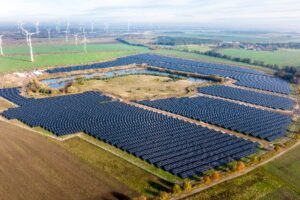Biofuels from Algae: A Sustainable Energy Source

Biofuels obtained from algae can replace the liquid fossil fuels used today by our vehicles and also the biofuels produced from corn and sugarcane.
When burning, algal biofuels release only CO2 (that is consumed by plants), which means that this type of biofuels are cleaner than the fossil fuels such as coal, oil and natural gas. Let’s see what are biofuels from algae.
Algal Biofuel Definition
Biofuels produced from algae represent cleaner fuels compared to regular fuels, and can be used as a green alternative to fossil fuels produced from crude oil (diesel and gasoline) and used to power our vehicles for a cleaner environment.
Mankind is trying today to find cleaner ways of replacing the dirty fossil fuels used on a mass scale for energy, heat and fuel production because the massive release of greenhouse gas emissions in the atmosphere has led to climate change and strange weather conditions such as droughts and heat waves during the summer, very violent tropical storms, floods, extremely low temperatures during the winter, etc.
Generations of Biofuels
The biofuel industry considers that there are fourth generations of biofuels known today.
1. First Generation Biofuels
First-generation biofuels are using food crops containing sugars such as corn, palm, soy and sugarcane, and also starches and oils.
Fermenting the sugars contained by food crops or chopping up the fatty oils through a process called transesterfication will turn them into useful biofuels.
2. Second Generation Biofuels
Second-generation biofuels rely on lignocellulosic biomass produced from specific biofuel crops such as corn stalks, switchgrass, agricultural waste and poplar trees.
To produce biofuels from lignocellulosic biomass, specially designed microorganisms are used to broke down the cellulose into sugars, which is then fermented to produce ethanol and other biofuels.
3. Third Generation Biofuels
Third-generation biofuels rely on algae as feedstock to produce a wide variety of biofuels such as biodiesel, petroleum and clean jet fuel.
Algae are still considered today a low-cost and high-energy renewable feedstock, even if many companies have tried, but failed to produce biofuels from algae on a mass scale.
Because a large quantity of food crops is used today to produce biofuels, algae have been considered a viable solution to biofuels production without using valuable food crops, which otherwise would enter the food production process for human and animal consumption.
4. Fourth Generation Biofuels
Fourth-generation biofuels include synthetic fuels (electrofuels) and synthetic chemical fuels (photobiological solar fuels).
Electrofuels represent today an emerging class of carbon-neutral alternative fuels that are produced by storing electrical energy generated by different types of renewable energy sources in the chemical bonds of gas and liquid fuels.
The primary fuels suited for this process are hydrogen, butanol, biodiesel, and also other alcohols and gases containing carbon such as methane and butane.
Synthetic chemical fuels (solar fuels) are produced directly or indirectly by the Sun using the sunlight and solar heat.
These synthetic fuels are produced through photochemical and photobiological processes (artificial photosynthesis), through thermochemical processes (concentrated solar thermal driving a chemical reaction) and through an electrochemical reaction.
Solar fuels can be generated and stored for later use (during the night when the sunlight is not available or during the cloudy and rainy days).
Types of Biofuels Produced from Algae
There are several types of biofuels that can be produced using algae such as: biodiesel, biobutanol, ethanol, green diesel (renewable diesel) and jet fuel (aviation biofuel).
1. Biodiesel
Biodiesel is a clean diesel fuel that can be produced using plant and animal lipids (oils and fats).
Some species of algae can produce a pretty large amount of biomass and usable oil (at least 60% of oil from their dry weight).
Microalgae are able to generate large amounts of biomass and usable oil, and the oil is then turned into biodiesel, which is used to power diesel vehicles in a cleaner way.
Microalgae have a faster growth rate compared to terrestrial crops mostly because these tiny algae are usually grown in floating and rich nutritional mediums.
At the same time, microalgae can turn much of their biomass into usable oil (a much higher fraction of oil is produced by microalgae compared to conventional crops).
2. Biobutanol
Biobutanol or clean butanol can be produced using the green waste that remains after the algae oil extraction.
Biobutanol has a pretty low energy density (only 10%) compared to gasoline, but can be used by gasoline engines as a cleaner fuel without any modifications made to the engine.
In terms of fuel consumption, biobutanol generates a similar consumption level as gasoline, but by blending biobutanol with gasoline we obtain a cleaner fuel with better performances and corrosion resistance.
Blending biobutanol and gasoline produces a cleaner fuel that works fine in gasoline engines and in terms of corrosion resistance is better compared to the blends of gasoline and ethanol or E85.
3. Ethanol
Ethanol can also be produced using algae not only food crops.
This way, Algenol (a U.S. based company founded in 2006, and headquartered in Fort Myers, Florida), uses photobioreactors to grow algae in a fully enclosed and controlled environment.
Air, water and the nutrients required to grow these algae are all filtered before being introduced in the enclosed system (to avoid any contamination specific to open ponds).
The algae production in the Algenol systems yields 2-3 times compared to the algae production in open ponds, and the high density monocultures are generating a product that features consistency and high quality.
The company uses algae, carbon dioxide, salt water and of course the sunlight, to produce ethanol, gasoline, diesel fuel and jet fuel.
4. Green Diesel
Green diesel or renewable diesel can be produced using the oil extracted from algae.
The oil produced from algae is turned into green diesel using a hydrotreating refinery process that will break down the molecules into shorter hydrocarbon chains, which can be used in diesel engines.
Due to the fact that green diesel has the same chemical properties as regular diesel fuel, it can be used in diesel engines without any modifications, and can be distributed through pipelines and the infrastructure used by oil-based diesel fuel.
5. Clean Jet Fuel
Airline companies such as Lufthansa and Virgin Airlines have started in 2008 the trials to use algae as a source of jet biofuel.
However, in 2017, there was still a small progress in the production of jet biofuel using algae, mostly due to the fact that many companies growing algae for biofuel production have decided to close their business or changed their business toward other commodities, such as animal feed, cosmetics, and even specialty oil products.
At the beginning of 2019, we see companies in Asia (India) and other areas of the planet, that have decided to turn the Jatropha oil (instead of algae) into a clean bio-jet fuel used in a few commercial flights to lower the emissions produced by regular jet fuel.
Final conclusion
We can find on our planet many colors of algae from red and yellow algae to purple, brown, black, green and even blue-green algae.
All algae absorb sunlight, which is turned into energy.
Algae represent a source of food for many types of freshwater and salt water animals and also birds.
At the same time for us, algae represent a great source of renewable energy made from sunlight, carbon dioxide and water, which can be turned in a very sustainable and renewable fuel.







